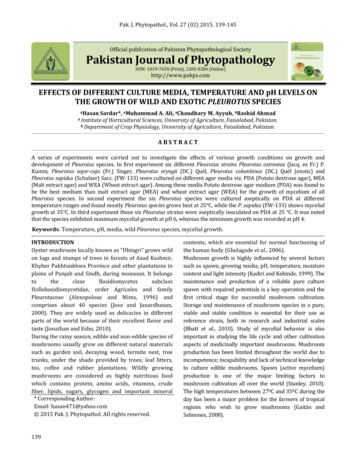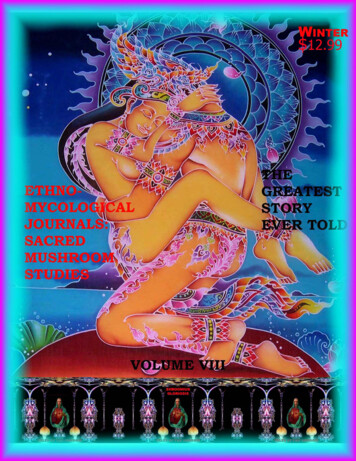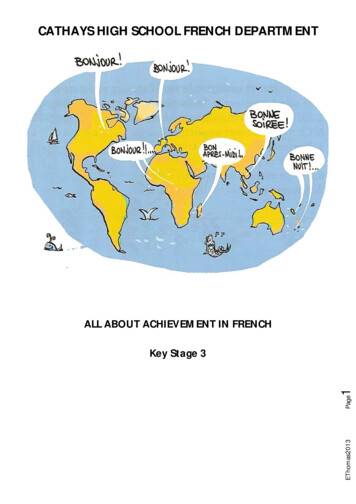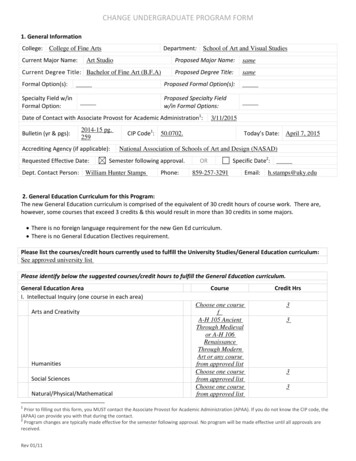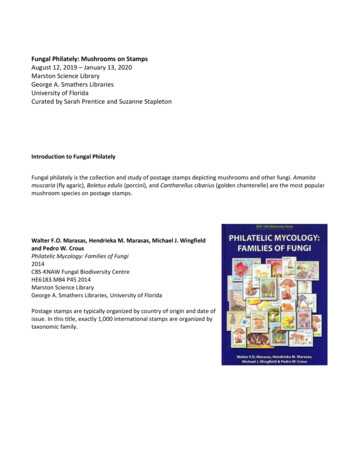
Transcription
Fungal Philately: Mushrooms on StampsAugust 12, 2019 – January 13, 2020Marston Science LibraryGeorge A. Smathers LibrariesUniversity of FloridaCurated by Sarah Prentice and Suzanne StapletonIntroduction to Fungal PhilatelyFungal philately is the collection and study of postage stamps depicting mushrooms and other fungi. Amanitamuscaria (fly agaric), Boletus edulis (porcini), and Cantharellus cibarius (golden chanterelle) are the most popularmushroom species on postage stamps.Walter F.O. Marasas, Hendrieka M. Marasas, Michael J. Wingfieldand Pedro W. CrousPhilatelic Mycology: Families of Fungi2014CBS-KNAW Fungal Biodiversity CentreHE6183.M84 P45 2014Marston Science LibraryGeorge A. Smathers Libraries, University of FloridaPostage stamps are typically organized by country of origin and date ofissue. In this title, exactly 1,000 international stamps are organized bytaxonomic family.
Four stamps from different nations all depict the golden chanterelle,Cantharellus cibarius: Mongolia, 1985; Nicaragua, 1990; Poland(Polska), 1959; Romania (RP Romina), 1958. The Romanian stamp ispart of the first set of stamps depicting mushrooms ever issued.Loan courtesy of Sarah PrenticeInstructional model of Cantharellus cibariusGermanyLoan courtesy of UF Department of Plant PathologyDenise Binion, Steven L. Stephenson, and William C. RoodyMacrofungi Associated with Oaks of Eastern North America2008West Virginia University PressQK604.5.B56 2008Marston Science LibraryGeorge A. Smathers Libraries, University of FloridaMembers of the genus Cantharellus, commonly called chanterelles, are choice edible mushrooms popularamong local foragers. Accurate identification is critical; never consume wild mushrooms without expertidentification.Penicillin: A Fungal HeroScottish scientist Alexander Fleming discovered the fungal mold Penicillium by accident in 1928, when itcontaminated bacterial cultures in his laboratory. It was later refined to produce the first modern antibiotic drugpenicillin, revolutionizing the treatment of infectious diseases.Kevin BrownPenicillin Man: Alexander Fleming and the Antibiotic Revolution2005Sutton PublishingQR31.F5 B76 2005Marston Science LibraryGeorge A. Smathers Libraries, University of Florida
Mauritius50th Anniversary of the Discovery ofPenicillin1978Loan courtesy of Sarah PrenticeDesigned by Jessica Toombs, thiscommemorative sheet includes areproduction of Fleming’s handwrittenlab notes when he first recognizedPenicillium notatum suppressing thegrowth of Staphylococcus bacterialcolonies.Kenneth B Raper and Charles ThomManual of the Penicillia1949QK 623.P4 R3Marston Science LibraryGeorge A. Smathers Libraries, University of FloridaOne of the first challenges for medical application of penicillin was producing quantities to meet human needs.Initially, the fungus was grown in petri dishes; later, new techniques and selected strains significantly increasedyields.EruserPenicillum crysogenum 3D ModelMarch 27, nce/medical/penicillium-chrysogenumPrinted by Marston Science Library 3D LaboratoryThis model is a magnification of the reproductive structure of Penicillium. Most fungi reproduce by spores, whichmay be either sexual or asexual. Conidia (asexual spores) of Penicillum crysogenum are borne on specializedstalks called conidiophores.Lisa Yount, ed.Antibiotics2005615.329 AntMead LibraryGeorge A. Smathers Libraries, University of FloridaOveruse of the antibiotic penicillin has led to growth of resistant bacteria. The World Health Organizationdeclares antibiotic resistance as “one of the biggest threats to global health, food security and developmenttoday” (World Health Organization Antibiotic Resistance Fact Sheet, 2019)
MycologistsMycologists study mushrooms and fungi. Three notable North American mycologists are featured on the stampsheet Les Mycologues from the Central African Republic. These mycologists were avid collectors not only offungi, but also of art, books, shells, and stamps.Central African RepublicLes Mycologues (The Mycologists)2001Loan courtesy of Sarah PrenticeWilliam Alphonso Murrill (1869-1957) worked at the New YorkBotanical Gardens and founded Mycologia, the official journal ofthe Mycological Society of America. He spent the last severaldecades of his life at the University of Florida, where he describedhundreds of species of fungi from local woodlands, and is buried inEvergreen Cemetery, Gainesville.Fred Jay Seaver (1877-1970) worked at the New York BotanicalGardens from 1908 to 1948 and succeeded Murrill as editor of thejournal Mycologia. Seaver studied, described and published on the cup fungi that includes such well-knownfungi as the morels and crimson cups.Arthur Henry Reginald Buller (1874-1944) was a British-Canadian mycologist and plant pathologist. He chairedthe Department of Botany at the University of Manitoba from 1904 to 1936. His best-known academic work isthe seven-volume Researches in Fungi.Arthur Henry Reginald BullerCarpe Fungum1927Library and Archives CanadaBuller designed this bookplate for his personal library. Carpe Fungummeans “collect the fungi.”
Fred Jay SeaverPhillipsia chardoniana SeaverFrom the North American Cup-Fungi (Operculates)1961QK623.D6 S4 1961Plant Diagnostic Center LibraryUniversity of FloridaThis striking cup fungus is now known as Phillipsiadomingensis and may be found locally.G.F. WeberWilliam A. Murrill in Florida1942LuEsther T. Mertz Library Vertical FilesNew York Botanical GardenMurrill’s “first joy and pleasure in his retirement was the study offleshy fungi of Florida, wherein he described over 600 forms ofagarics and over 50 polypores and hydnums. Dr. Murrill was anardent photographer and artist; he was a capable writer, critic,and editor; he was a collector not only of fungi but of items of art,sculpture, paintings, stamps, and shells ” (Weber, 1961).Weber, G. 1961. William Alphonso Murrill. Mycologia, 53(6), 543557. Retrieved from http://www.jstor.org/stable/3756456Sarah PrenticeLoblolly Woods Nature Park Foray2018Courtesy of Sarah PrenticeModern-day amateur mycologists collect and identifymushrooms during a fungal foray with the FloridaAcademic Lichen and Fungi Enthusiasts League (FALAFEL).
Mushroom DiversityA mushroom is the fleshy above-ground fruiting body, or reproductive structure, of a larger fungal organism.Mushrooms are incredibly diverse, produced in a number of shapes, sizes, and colors. Fascinating features ofsome mushrooms include the ability to glow (bioluminesce).United StatesBioluminescent Life2018Loan courtesy of Sarah PrenticeLiving organisms that emit light arebioluminescent; fireflies are a common example.This stamp sheet portrays ten differentbioluminescent organisms, including the firstmushroom-themed stamp issued by the U.S.Postal Service. Mycena lucentipes wasphotographed by Taylor Lockwood of Mt. Dora,Florida.Cassius V. StevaniMycena luxaeternaFrom Mycologia vol. 102, no. 22010QK600 .M8Marston Science Library,George A. Smathers Libraries, University of FloridaMycologia has been a major publication for mycologistssince its inception in 1909. It was first published by the NewYork Botanical Garden under the editorship of W.A. Murrill.This cover shows light and dark images of a bioluminescentspecies recently described from Sao Paulo, Brazil.
Bulgaria1987Loan courtesy of Sarah PrenticeUnusual for mushroom-themed stamps, this setincludes a cross-section line drawing of eachspecimen. Notice that some of these mushroomshave gills on the underside of the cap, whileothers have closely-packed tubes that form apore surface.Sam NorrisParts of a MushroomFrom Mushrooms of the SoutheasternUnited States by Alan E. Bessette,William C. Roody, Arleen R. Bessette,Dail L. Dunway2007Syracuse University PressQK605.5 .S67 M87Marston Science LibraryGeorge A. Smathers Libraries, Universityof Florida
George A. Smathers Libraries, University of Florida . Overuse of the antibiotic penicillin has led to growth of resistant bacteria. The World Health Organization declares antibiotic resistance as "one of the biggest threats to global health, food security and development today" (World Health Organization Antibiotic Resistance Fact Sheet, 2019)




